20-May-2018 – Technology runs a sailboat and always has. In our age, technology has become synonymous with electronics. On a sailboat, electronics is just one of many.
Let’s start with Caro Babbo’s most troubling technology, cooking:
Taylor’s Stove
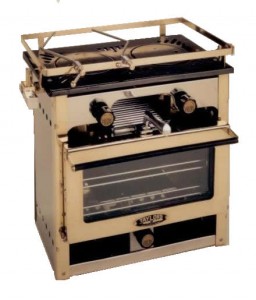
2016, on the advice of most pump jockeys, we used Jet A as a fuel. Jet A burns significantly hotter than kerosene. The hotter fuel caused the fuel in the bottom of the burner and the fuel line to turn into hardened carbon: coke.
[15-DEC-2019 – We eventually tracked all of the stove problems to using the wrong fuel. One MUST use 1-k Kerosene. Nothing else will work. Marine stores carry it, as do most home improvement stores like Home Depot and Lowes.]
A possible mistake in 2017 was not cleaning out the fuel lines before replacing the burners. The coke remaining in the fuel line clogged the two stove-top burners.
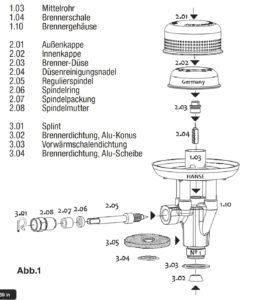 The burners that now come with the stove are referred to as four-leg burners because there are four supports for the burner top. They are made by Hanse in Germany and said to be much better than the original two-leg burners.
The burners that now come with the stove are referred to as four-leg burners because there are four supports for the burner top. They are made by Hanse in Germany and said to be much better than the original two-leg burners.
Both the two legged and four legged burners use some method to meter the fuel and reduce the pressure to the fuel jet, the same as the pressure regulator on your propane barbecue.
On the two-legged burners there was a removable and replaceable fitting that looked similar to a jet.
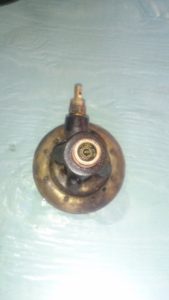 On the four legged-burners, the metering system is a ribbon of brass screen that is wound tightly and fills the bottom of the burner. In 2016, the vendor I bought the stove from offered to rebuild the burners for free, if sent them back to him in England. When they arrived, he told me they could not be serviced, that the castings were cracked and I would need to buy three new ones.
On the four legged-burners, the metering system is a ribbon of brass screen that is wound tightly and fills the bottom of the burner. In 2016, the vendor I bought the stove from offered to rebuild the burners for free, if sent them back to him in England. When they arrived, he told me they could not be serviced, that the castings were cracked and I would need to buy three new ones.
I told him I would buy the replacement burners from him if he would return the three that I returned so I could tear them apart and learn how they worked. To deal with him cost an extra $45 USD because he will not accept credit cards or electronic payments, like PayPal. He did not return the used burners. I don’t deal with him any more.
There is a very good service-oriented vendor who stocks all parts on line and accepts all major credit cards – and quickly and politely answers questions.
The stove burners require maintenance, This week I performed maintenance on the burner we have been using the most. In place of hardened coke was a greasy build up of sludge, which was easily cleaned out, I cleaned out the jet using the internal cleaning needle and replaced the needle valve shaft, which we had broken by forcing the handle in the wrong direction. The burner seems to work as good as new.†
The recurring question: would I have bought the $6500†† Wallis stove over this $3500 Taylor’s stove if I had it to do over again, and will I replace the Taylor’s with a Wallis this fall?
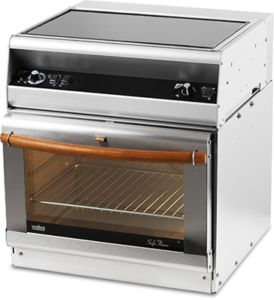
Yes, I would buy the Wallis if I had to do this over again with what I know now.
My fear of the failing Wallis electronics was not justified… I could keep a backup mother board as a spare. The single fuel is a great advantage.
The Taylor’s stove is 1930s technology. That should have been the red light. There is a reason that technology was abandoned – As a contrast, Pratt & Whitney radial aircraft engines designed in the 1920s are still in use and may still be in production because no one has come up with a better design.
Once I abandon the fear of the Wallis electronics, there are a few advantages that that the Taylor’s has: The flame is quickly adjustable: You can sauté on the Taylors and turn the flame down to simmer. The Taylor’s requires no electricity to run.
The Wallis heats a metal plate on which cooking pots are placed. It is very much like cooking on a steel grill – the same can be done on the Taylor’s by placing the stove lids* in place. Turning the heat up and down is a slow process and I do not believe one can sauté on it.
The Wallis is modern technology. The company makes a complete line of stoves and heaters using this technology. And, it would get rid of the alcohol and kerosene (#1 Diesel) that we must acquire and store.
Will I replace the Taylor’s this fall? I am definitely thinking about it. The costs are sizable. I expect I can only net a little more that a thousand dollars on the Taylor’s once I install new burners etc to get it ready for sale. That makes the Wallis a $5500 investment.
I will be looking into having one of my Maxi 95 friends ship me one directly from Finland, if that can yield a sufficient savings.
Sails
We’re in our second season with the new sails that Jim Kitchen had made for us. They are great, but at 8.3 oz, they are very heavy. Storing the 135% genoa in the bow sail locker requires standing on the sail to get it to fit and using the halyard winch to drag it out of the locker when I’m raising it.
It seems to be a bit more sensitive to forestay tension, but we love it and the loose footed main.
We continue to use our vintage 1977 170% Genoa in light airs. We didn’t fly our symmetrical spinnaker last year but hope to this year.
Portland Pudgy Dinghy
We continue to love the hell of the Portland Pudgy. It has been a great dinghy and straps onto our deck (after we moved from a baby stay to forward shrouds).
As I wrote recently, we did not replace the loose straps that held the lee boards in place when the dinghy was stored on deck, and we lost them in some recent strong winds.
We will order new ones next week. We hate to think what they will cost.
We have sailed the dinghy, and it moves well in light airs.
Engine
The Yanmar is completely reliable, but I must bleed the fuel line before starting the engine each time. I have replaced everything from the injector pump back to the fuel tank, including the mechanical lift pump, all of the lines, the filter holder (with a racor) and the valve to the tank.
I am open to someone coming onboard, if they think they can fix this problem.
The current plan is to add an electric fuel pump to pressurize the fuel line rather than have a vacuum line as it is now.
We have successfully used our new Suzuki outboard on the Portland Pudgy. Yay. It is not broken in, but works well and has the correct shaft length. We need to pick up shear pins for the propeller somewhere along the line.
Communications
Our VHF radio is working well after we suffered, unknowingly, with a defective radio for two years.
We have recently replaced the entire antenna system and now have an antenna that works well. I should have insisted that the tech put a meter on the finished antenna. Our AIS software says the antenna is within limits but not perfect.
Both the AIS and the VHF are working well. We see ships at a distance and they see us.
They also hear us clearly when we speak.
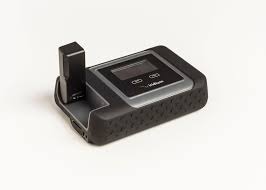 Our Iridium GO has been a boon and a life changer. It does two things reliably: makes voice calls and sends and receives texts.
Our Iridium GO has been a boon and a life changer. It does two things reliably: makes voice calls and sends and receives texts.
It claims to do internet stuff, but we’ve come to view that as a small marketing joke. Email seems to work relatively reliably.
I think most of the problem is the very poor vendor-supplied software. There is an opportunity here that I would like exploit.
The Predict Wind brand software, which we use to download grib files, has very good retry logic and works quite well. The rest is a mess. To be honest, I wouldn’t have let my people release this as a private beta; the copyright is 2013, with no copyrighted updates.
The idea that it could ever be used for websites is a stretch, but there are some data compression services out there that might make a go of it. Generally, the browser Iridium supplies just times out. The connection is 2400 BAUD.
There were some protocols designed for very slow serial connections that I want to revisit. Kermit comes to mind. Frank Dacruz, where are you?
With the Iridium, we can make calls and send texts easily and reliably, and receive texts. This takes much of the worry about being out of touch away.
Heating
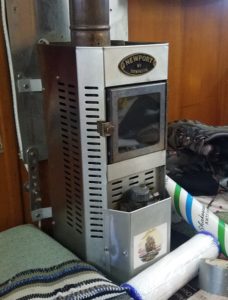 Our Newport Diesel ‘‘fireplace’’ is dependable and we use and enjoy it. It requires a chimney through the deck, which we must set up; the opening is covered when the dinghy is on the deck. So we have limited its use to where we are staying long enough to use the dinghy.
Our Newport Diesel ‘‘fireplace’’ is dependable and we use and enjoy it. It requires a chimney through the deck, which we must set up; the opening is covered when the dinghy is on the deck. So we have limited its use to where we are staying long enough to use the dinghy.
Our Webasto is working fine after having it serviced. I have to redo the electrical wiring on board, because we are getting a significant voltage drop from the batteries to the electrical panel. The webasto will signal a low voltage error when heating the ignition coil if the battery voltage is below 12.2 volts.
The error should only be signaled when the voltage is below 10.0 volts for more that 20 seconds.
The Taylor’s stove has become the primary heat source and works well. Using it this way probably increases the hours ten-fold, but it was sold to me to be used this way.
Electrical/Charging
The entire electrical panel and associated wiring needs to be replaced and will be the big project this coming fall/winter. The panel is all soldered fuses, which violates the ABYCA standards, and we are experiencing too large a voltage drop.
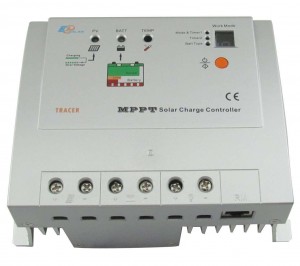
Having said this, I need to investigate the MPPT solar-panel charging regulator. The power to the panel runs through the charging regulator. The regulator seems to have been designed to power lights. There is logic to turn on lights when the output from the solar panels drops. It is possible that the regulator can not put out the necessary power and we’re seeing a drop here.
The MPPT regulator works well and I am very please with it. This year there has been time to experiment with aim the panels directly at the sun, and I have seen 60 watt increases in output on a 100 watt panel when angling the panel directly at the sun rather than obliquely. There are some stalk style mounts that I may try to have shipped to us while on this trip.
Charging from the engine does not completely charge the batteries because a splitter apparently drops the output voltage by a complete volt: we never see more that 13.4V coming from the alternator. I’ll work on this this fall as well.
We have not been connecting to power when at a dock, but now will do so occasionally to top of the batteries and run through a de-sulfate cycle. We did this in Port Hardy and there was a significant change in battery behavior. The solar panels will top off the batteries. We’re pleased with the setup we have, 160 watts, but will probably move to 200 watts so that we have symmetrical panels.
We have made some new friends, Shane and Kendra, about a brand-spanking new Juneau Sun Odyssey 44 DS. Shane has spoken highly of moving to Lithium Ferrous batteries. The couple on Gladiator III also recommended Lithium Ferrous batteries. There will be much to investigate.
Water
We love the Power Survivor 40E water maker. We can’t say enough good. It works well and is reliable.
This has been the year of freshwater leaks: we currently have a leak from the port side water tanks. I believe it is a hose and will work on it in Ketchikan while Jennifer is in Atlanta.
Among the other fresh water leaks: I have fixed the leak from the starboard water bladder; I fixed the symptom from the deck leak into the aft cabin starboard locker by drilling a hole in the bottom of the locker.
In the hard sailing recently we found that the starboard windows in the main cabin leaked. I have never resealed those windows, but did with a liberal application of 3M’s 4000.
On the flip side, the pump on the toilet is leaking when pumped. I was supposed to buy a replacement part at Fisheries, which needs to be special ordered, and did not. The holding tank is working well, both holding and emptying.
Self-Steering
This year we re-calibrated our Raymarine 4000+ ST self steering. The difference has been wonderful in terms of accuracy and reliability.
I have yet to completely install the Sailomat 3040. There is an adhesive that was used to set the steering oar adjustment, and I have not taken the adhesive off. I expect it will need heat. I had thought it was epoxy, buy know I am starting to think it is 3M 5200, an acrylic, for which there are new solvents and I believe heat will also work.
Every time I think I am finished with this post I think of other technologies that we use. Time to end this.
Thanks again for reading and following. Please tell others who yoy think might enjoy this blog.
–––––––––––––––––––––
* Mark Twain mentions stove plates in his advice: Be not like the cat who after havign sat on a hot stove lid will never sit on a hot stove lid again, nor a cold one.
† Three days later, the burner stopped working entirely, so we’re back to a one burner stove. Both the manual and a woman on line say to soak the burner in ammonia. I will give that I try a day when we are away from the boat.
†† The price seems to have dropped close to a thousand dollars, but with sales tax, the total it sill over $6K.
